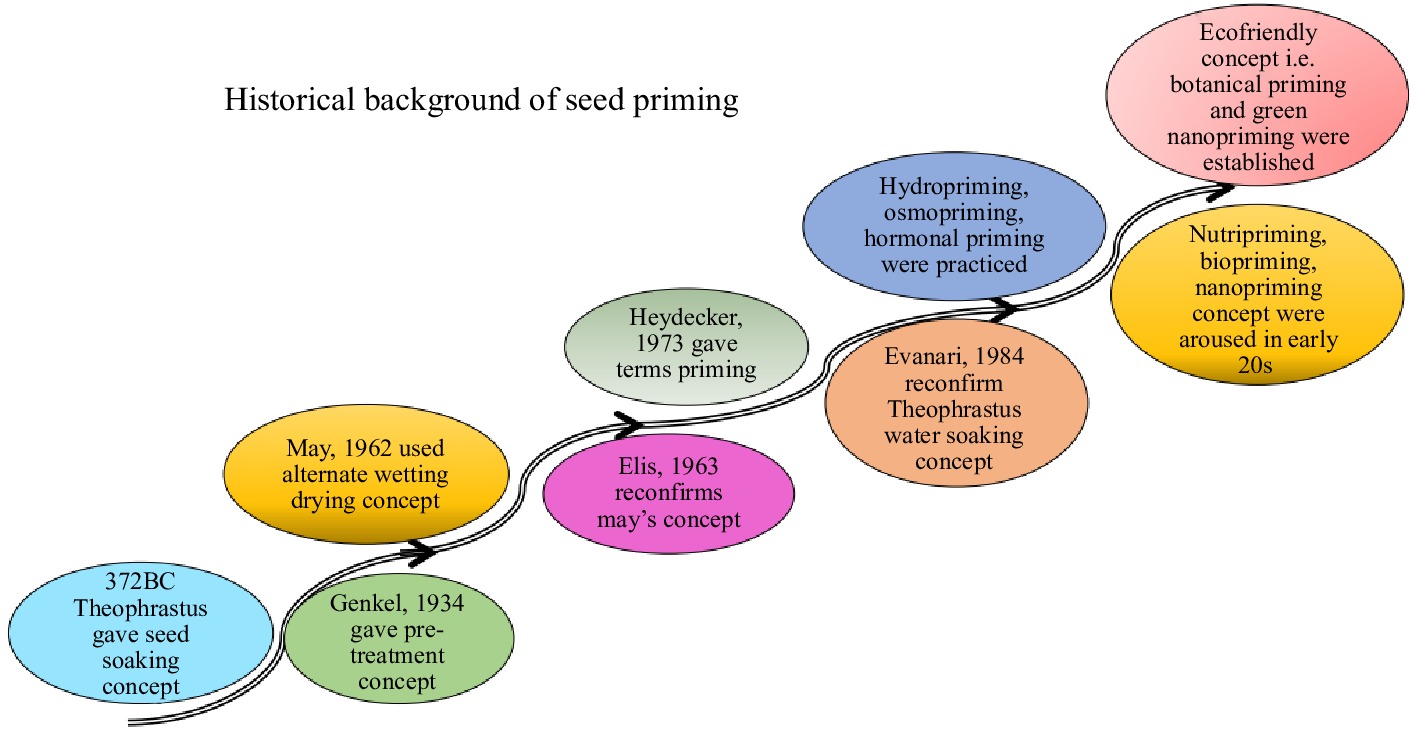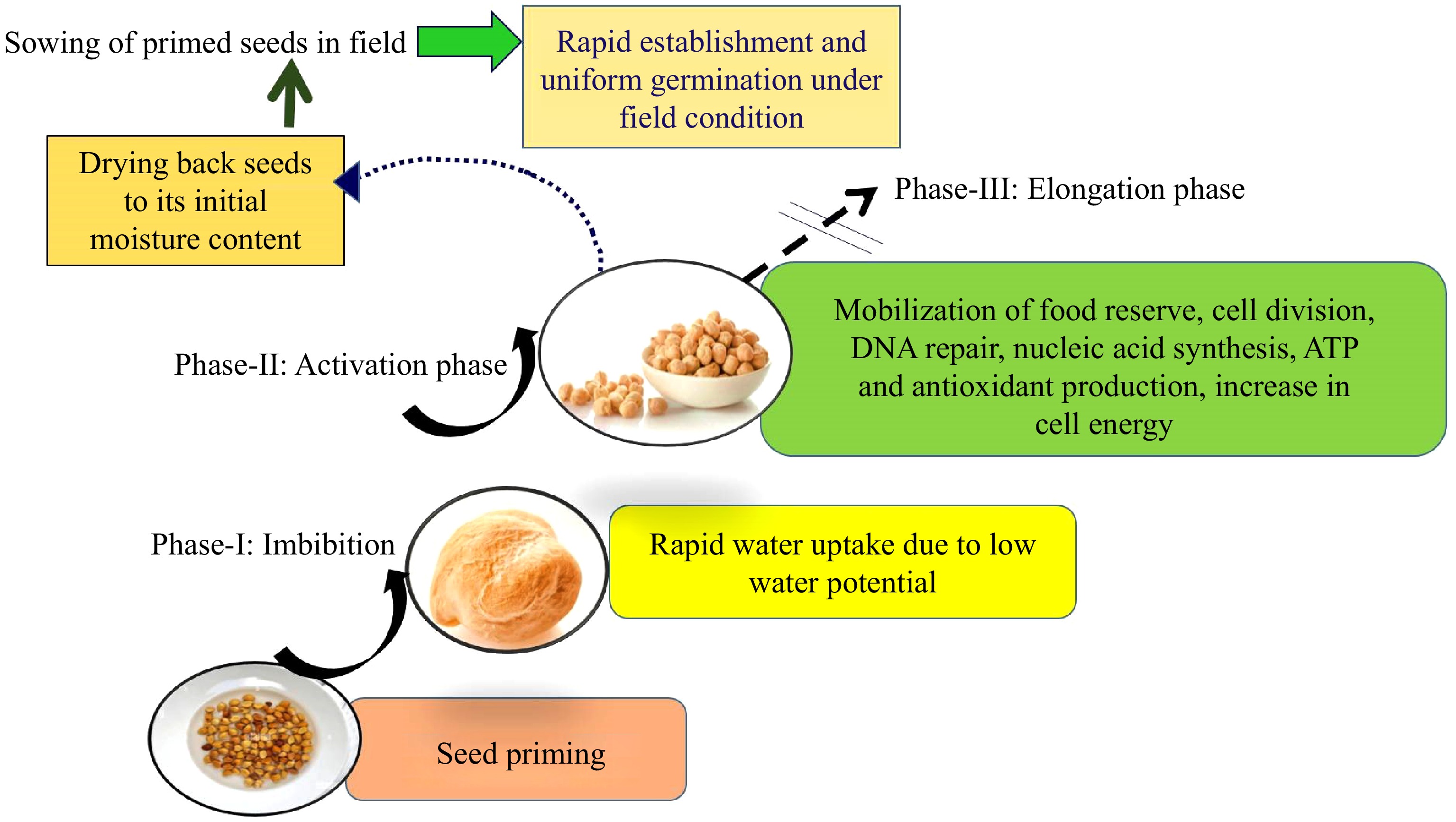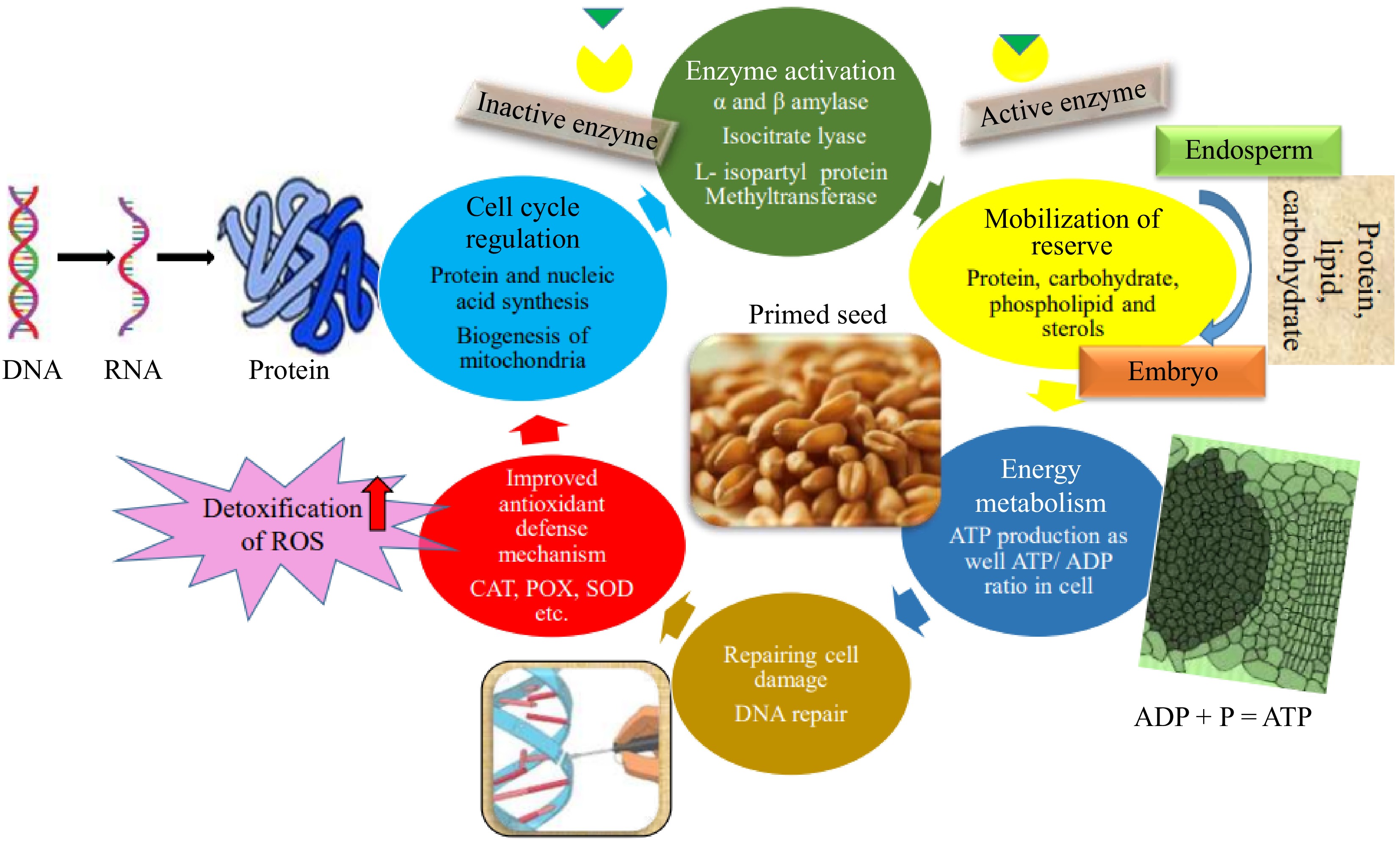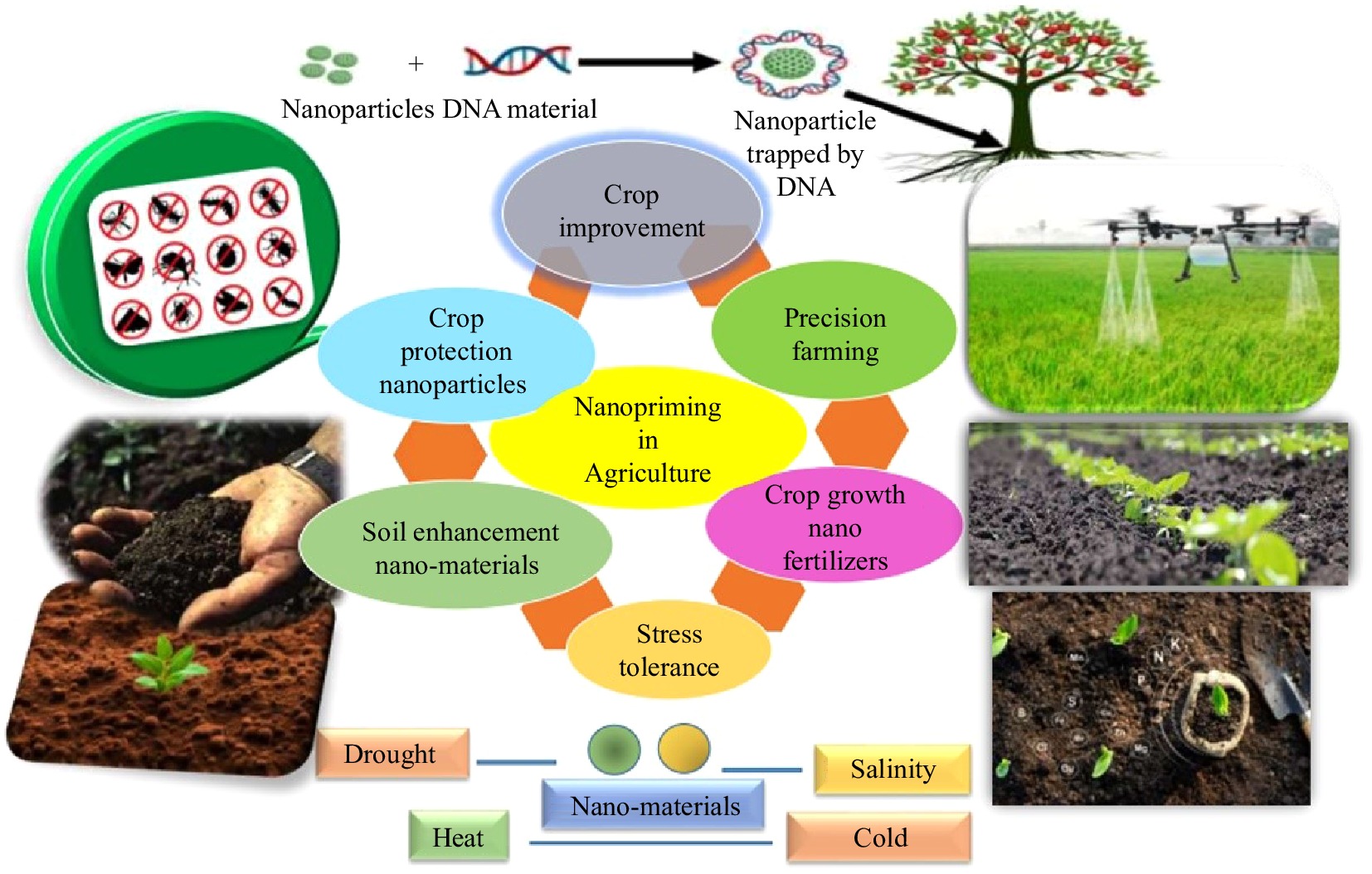-

Figure 1.
Representation of periodical evolution of priming techniques.
-

Figure 2.
Sub-cellular changes during seed priming.
-

Figure 3.
Schematic representation of seed priming inducing metabolic reprogramming in seeds, leading to enhanced germination and early seedling growth.
-

Figure 4.
Various applications of nanopriming in agriculture, showing the nanoparticles can be used for crop improvement, protection, precision farming, and enhancing stress tolerance.
-
Sr. no Crops Types of nanoparticles Effect of nanoparticles Ref. 1 Wheat Multi-walled carbon nanotubes Improved seed vigor, plant morphology, and harvest [40] 2 Wheat Iron nanoparticles Improved seed vigor and plant morphology, and increased harvest yield [41] 3 Wheat Silicon nanoparticles Increased biomass and biochemical activity, and reduced cadmium uptake [42] 4 Wheat Zinc oxide nanoparticles Reduced cadmium uptake [36] 5 Wheat Zinc oxide nanoparticles Improved growth biomarkers under salt stress [43] 6 Wheat Copper nanoparticles Abiotic stress resistance development [44] 7 Wheat Silver nanoparticles Increased seed and seedlings vigor [45] 8 Rice Iron (II) sulfide aqua nanoparticles Improved seed vigor and disease resistance [46] 9 Rice Silver nanoparticles Upregulation of aquaporin gene expression, improved seed and seedlings vigor [6] 10 Rice Zinc oxide Improved biofortification [47] 11 Rice Iron nanoparticles Improved enzymatic activity [48] 12 Rice Silver nanoparticles Increased aquaporin gene expression [49] 13 Maize Chitosan nanoparticles containing zinc Improved seed and seedling vigor, and biotic resistance [50] 14 Maize Chitosan nanoparticles containing copper Improved seed and seedling vigor [51] 15 Maize Gold nanoparticles Improved seed and seedling vigor [34] 16 Maize Zinc oxide Increase grain weight, K+ content, and α-amylase activity under salt stress [52] 17 Common bean Zinc nanoparticles Increased biomass [53] 18 Common bean Copper nanoparticles Increased seed vigor, and biomass [44] 19 Common bean Copper nanoparticles High concentrations showed toxic effects on seed germination [44] 20 Soybean Cobalt and molybdenum oxide nanoparticles Improved seed vigor, and plant morphology with increased biomass [54] 21 Soybean Silver nanoparticles Potential antimicrobial activity [55] 22 Tomato Chitosan loaded with gibberellic acid Improved seed vigor and plant morphology with increased biomass [56] 23 Tomato Lignin nanoparticles loaded with
gibberellic acidImproved seed and seedling vigor [57] 24 Tomato Selenium nanoparticles Increased total antioxidant capacity, and chlorophyll content [58] 25 Watermelon Silver nanoparticles Improved seed vigor, and plant morphology [59] 26 Watermelon Iron nanoparticles Increased the activity of plant growth regulator [60] 27 Watermelon Iron oxide nanoparticles Improved plant morphology, reduced phytotoxicity [61] 28 Chili titanium and silver Improved seed vigor, increased disease resistance [62] 29 Chili Zinc oxide nanoparticles High antimicrobial activity [62] 30 Chili Manganese (III) oxide nanoparticles Increased salinity resistance, and antioxidant enzymes [36] 31 Chickpea Lignin nanoparticles loaded with
gibberellic acidImproved seed and seedling vigor [57] 32 Chickpea Zinc oxide nanoparticles Significantly mycelial growth inhibition of Fusarium oxysporum, and increase biochemical activity [63] 33 Chickpea Molybdenum Increased antioxidant enzymes, and harvest [64] 34 Sorghum Iron oxide nanoparticles Increased biochemical activity and biomass, and improved water content in leaves [65] 35 Pearl millet Zinc oxide nanoparticles Antimicrobial resistance [66] 36 Onion Silver nanoparticles Potentially increased bio-chemical activity [67] 37 Onion Gold nanoparticles Improved seed and seedling vigor [68] 38 Pea Platinum nanoparticles Decreased microorganism colonization [69] 39 Spinach Zinc nanoparticles Alleviation of salt stress [70] 40 Rapeseed Cerium oxide nanoparticles Upregulates the expression of salicylic acid biosynthesis under salt stress [71] 41 Cucumber Nanoparticles of water treatment residuals Increase salinity stress tolerance, and biomass [72] 42 Radish Manganese oxide nanoparticles Enhanced nutritional richness [73] 43 Lettuce Zinc, silicon, iron, copper, cerium, and titanium oxide nanoparticles Reducedthe accumulation of reactive oxygen species, and malondialdehyde content under cadmium toxicity [74] Table 1.
Effect of various nanoparticles in different field crops.
-
Factors Conventional
technologyNanotechnology
mediated agricultureRef. Yield and quality Low High [67] Crop productivity Low High [79] Nutrient use efficiency Low High [46] Effect on soil health and quality Negative Positive [80] Sustainable crop production Low High [81] Environment remediation Low High [82] Biotic stress and disease tolerance Low High [83] Usage of natural and waste resources for yield attributes Limited Exclusively high [84] salinity stress tolerance Low High [85] Drought stress tolerance Low High [86] Ecofriendly approach No Yes [87] Biomass production Low High [62] Reduction in Mn toxicity Low High [88] Reduction in Cd toxicity Low High [89] Table 2.
Comparative analysis of nanotechnolgy and conventional agriculture technology.
Figures
(4)
Tables
(2)